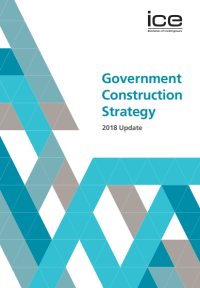ICE recommendations for the Government Construction Strategy 2018 update
Contents |
[edit] Introduction
The publication of the Government Construction Strategy 2016 2020 was effective in introducing policy to drive change, such as mandating BIM Level 2 across publicly procured projects.
Whatever your view on the specific direction of travel, the strategy is a valuable vehicle for providing a progressive and consistent approach across the members of the Government Construction Board - Department for Transport, Department for Environment, Food and Rural Affairs, Department of Education, Ministry of Justice, Department of Health, Defence Infrastructure Organisation, Environment Agency, Highways England, MHCLG and BEIS.
However, the sector has moved on and since the publication of the GCS there have been a number of commitments to different ways of working between government and the wider construction industry.
These include the commitment to offsite construction from 5 departments, the announcement of the Construction Sector Deal and the publication of the Infrastructure and Projects Authority’s report ‘Transforming Infrastructure Performance’ with the commitment to better alignment of outcomes, smarter infrastructure and improved procurement processes.
This increased level of ambition will require a step change in the government/industry relationship and deliver benefits for all parties involved - most importantly to society, the customers and users of the sector.
[edit] A more productive and sustainable construction industry
To provide an industry view, ICE harnessed the expertise of our members to develop proposals setting out 5 areas of opportunity for government to refine their approach in the following areas:
- Commercial strategy: Using government’s substantial influence effectively and consistently to stimulate a more sustainable and productive construction industry through following the best practice commercial principles set out in Project 13.
- Procurement process: To develop an approach that provides transparency and demonstrates value to the public sector while minimising the burden and costs of bidding for industry.
- Contracting approach: To provide a fair, open and transparent contract which supports the intent of the commercial strategy and the procurement process to successfully deliver the programme outcomes.
- Cross-government risks: Improving the visibility and mitigation of cross-departmental risks such as immigration, skills, and taxation resulting in increased delivery confidence and optimal use of available funding.
- Asset utilisation: Using the new opportunities presented through digital transformation to optimise the design, operation, integration and management of the assets as a system not individual entities.
[edit] Next steps
This submission is the starting point. The door is open for government to collaborate with industry to help shape the development of the GCS and together build a sustainable and productive future for construction and the UK.
ICE hopes to see government use its substantial influence effectively and consistently to help build an environment that fosters better working practices and deliver a step change in the relationship with industry.
This article was originally published by ICE as ‘Let's collaborate to make the future of construction better for all’ on 19 June 2018. It was written by Hannah Vickers.
--The Institution of Civil Engineers
[edit] Related articles on Designing Buildings Wiki
Featured articles and news
One of the most impressive Victorian architects. Book review.
RTPI leader to become new CIOB Chief Executive Officer
Dr Victoria Hills MRTPI, FICE to take over after Caroline Gumble’s departure.
Social and affordable housing, a long term plan for delivery
The “Delivering a Decade of Renewal for Social and Affordable Housing” strategy sets out future path.
A change to adoptive architecture
Effects of global weather warming on architectural detailing, material choice and human interaction.
The proposed publicly owned and backed subsidiary of Homes England, to facilitate new homes.
How big is the problem and what can we do to mitigate the effects?
Overheating guidance and tools for building designers
A number of cool guides to help with the heat.
The UK's Modern Industrial Strategy: A 10 year plan
Previous consultation criticism, current key elements and general support with some persisting reservations.
Building Safety Regulator reforms
New roles, new staff and a new fast track service pave the way for a single construction regulator.
Architectural Technologist CPDs and Communications
CIAT CPD… and how you can do it!
Cooling centres and cool spaces
Managing extreme heat in cities by directing the public to places for heat stress relief and water sources.
Winter gardens: A brief history and warm variations
Extending the season with glass in different forms and terms.
Restoring Great Yarmouth's Winter Gardens
Transforming one of the least sustainable constructions imaginable.
Construction Skills Mission Board launch sector drive
Newly formed government and industry collaboration set strategy for recruiting an additional 100,000 construction workers a year.
New Architects Code comes into effect in September 2025
ARB Architects Code of Conduct and Practice available with ongoing consultation regarding guidance.
Welsh Skills Body (Medr) launches ambitious plan
The new skills body brings together funding and regulation of tertiary education and research for the devolved nation.
Paul Gandy FCIOB announced as next CIOB President
Former Tilbury Douglas CEO takes helm.
























